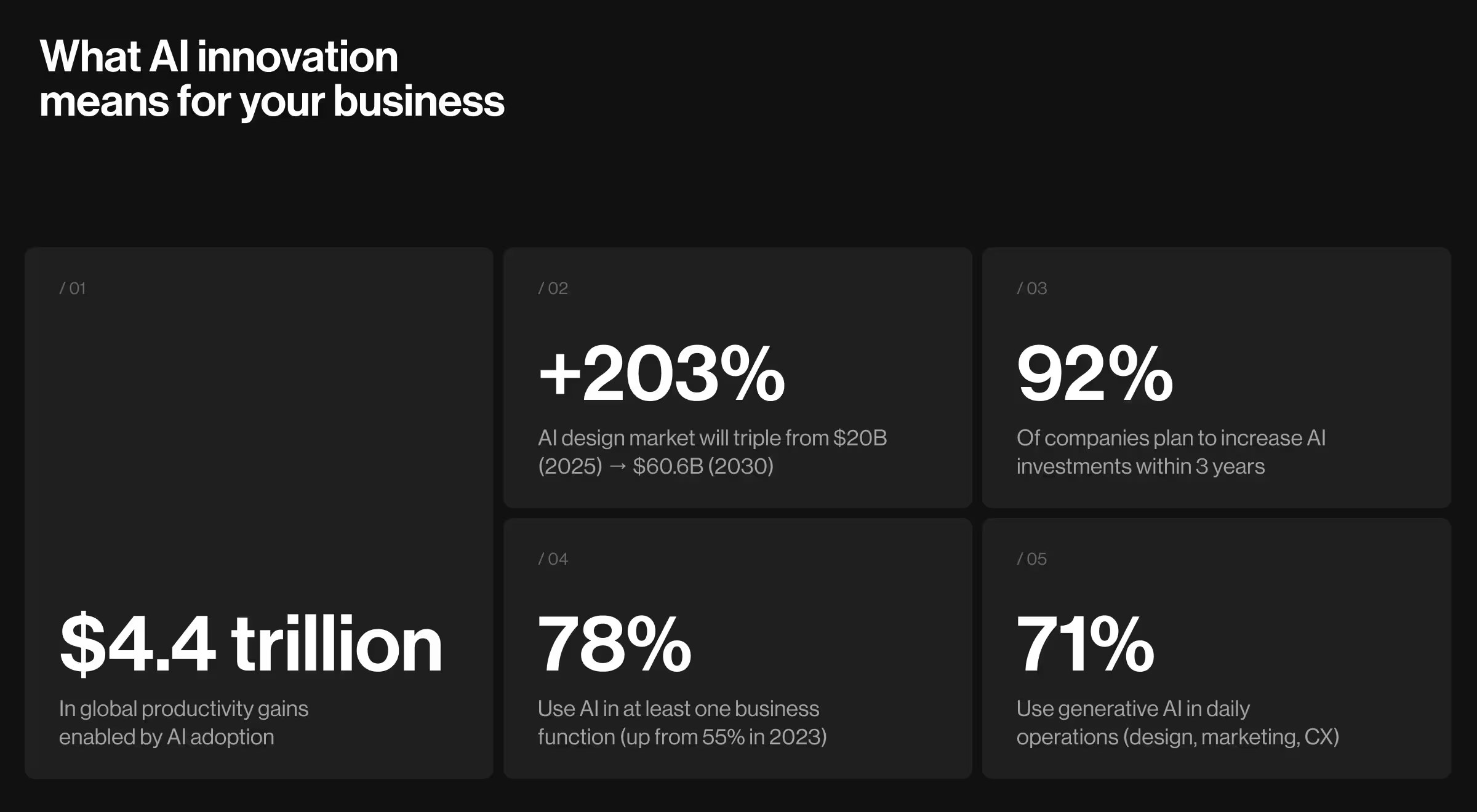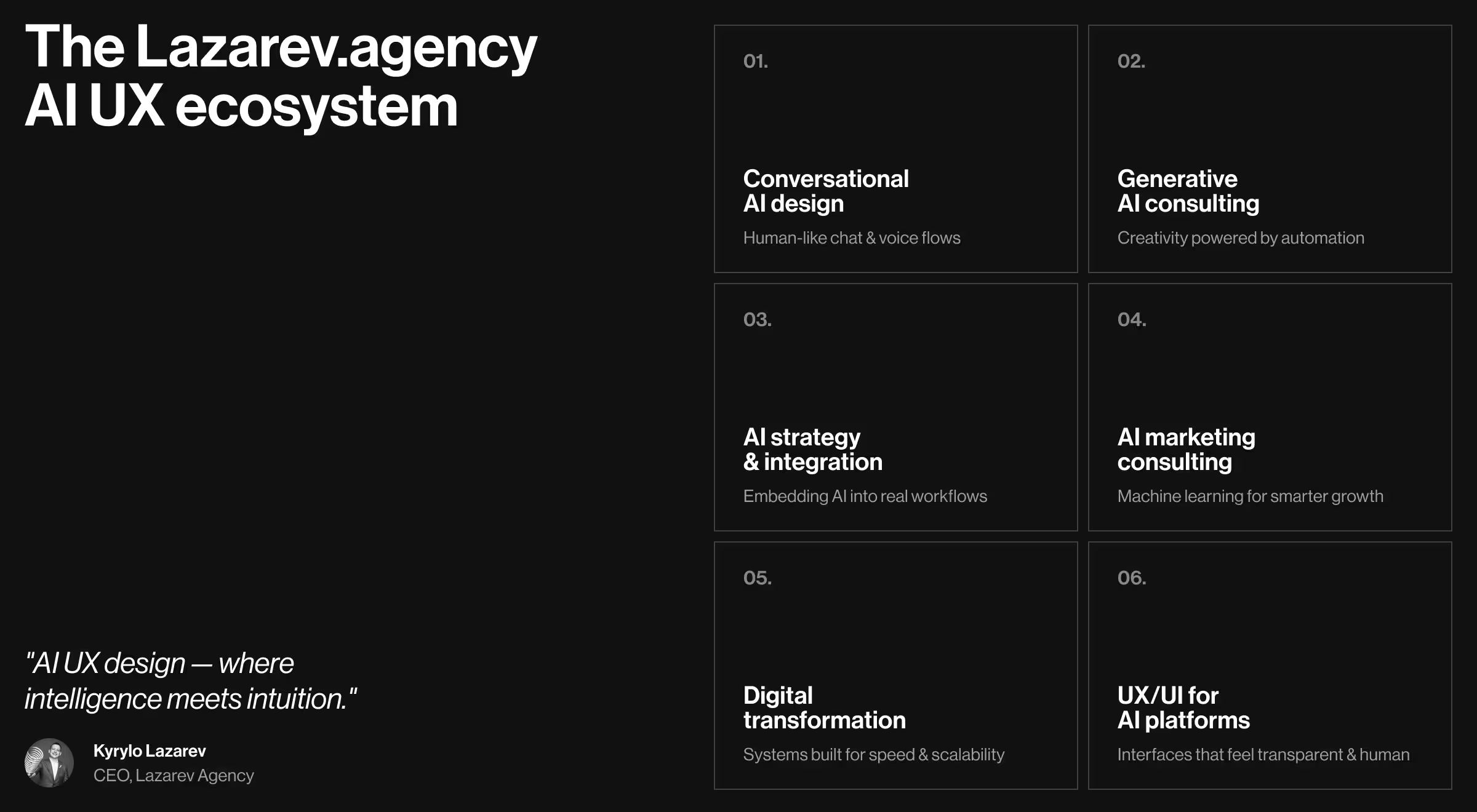Most people believe AI design is about sprinkling ChatGPT or Midjourney across their workflow and calling it innovation. It’s not. Real AI design agencies build interfaces where algorithms think and act in tandem with users.
Take Starbucks. Its Deep Brew AI redesigned customer experience from the inside out, optimizing menus and offering personalized recommendations across thousands of stores. That’s what happens when design and artificial intelligence are in tune.
Today, many agencies claim to offer AI design services, but few actually deliver agentic AI systems that boost performance. In this article, you’ll find out how AI design is reshaping industries, a list of top AI design agencies, and insights to help you choose a trusted partner.
Key takeaways
- AI design is the new digital literacy. It shapes how intelligent tools interact with users and determines the trajectory of your business growth.
- Numbers don’t lie. The global AI market is tripling by 2030, and top-performing companies are already building around it.
- The right AI design partner like Lazarev.agency matters. AI design is precision work built on strategy and systems thinking.
What AI innovation means for your business
Imagine your business as a race car. Strategy is the engine. Brand is the bodywork. AI is the turbocharger. And you can’t afford to leave the latter out. It’s what turns decent performance into record-breaking speed.
Across industries, companies acknowledge that AI innovation starts with a smarter digital presence. And those leading the pack have one thing in common: a strategic AI design partner like Lazarev.agency who knows how to turn algorithms into competitive power.
We’re past the experimentation phase. And numbers make this point undeniable:
- AI design market is expected to grow from $20 billion in 2025 to $60.6 billion by 2030.
- AI adoption could generate $4.4 trillion in global productivity gains.
- 92% of companies plan to increase AI investments within the next 3 years.
- 78% of organizations already use AI in at least one business function, up from 55% in 2023.
- 71% now apply generative AI in daily operations such as design, marketing, and customer experience.

Take figures as a mirror. Businesses that once treated AI as an experiment are now centering their operations around it.
That’s why designing with AI is a new digital literacy. It demands partners who understand both form and function and translate data intelligence into usable systems.
14 AI innovation agencies to have on your radar
Innovation doesn’t start and end with code. It takes smart design to turn intelligence into a tangible impact.
That’s what this table is here to show. Before diving into deeper profiles, use it as your quick compass through 14 leading AI innovation agencies.
Each one approaches innovation differently, and this snapshot helps you see who might be an ideal fit for your next big project.
Editorial analysis: how to read the AI design market
AI innovation isn’t one-size-fits-all. Some agencies design intelligence; others simply connect APIs. The difference shows in how they approach reasoning, usability, and scale. Below is a quick editorial map for the table navigation to help you read the landscape and know which type of partner fits your product stage.
Market archetypes
Across the 14 agencies, several clear archetypes emerge:
- AI-first, UX-led (agentic systems & reasoning UX) — Lazarev.agency, Cieden
Specialists in designing interfaces where AI doesn’t just respond, it collaborates. Think hybrid chat-plus-dashboard systems, data reasoning, and human-AI transparency. - Engineering-heavy transformation partners (enterprise modernization) — Momentum, EnterBridge, Crafted, SOtechnology
Ideal for organizations modernizing legacy operations. These teams combine deep tech and IT strategy to weave AI into production systems. - Generative & brand activation (applied GenAI at scale) — GenAI.Labs USA, SPARK6, Non-linear Studio
Creative agencies proving that generative AI can elevate storytelling, content, and commerce when guided by strong design. - Operational AI agents (workflow automation) — Inventive Works, SOtechnology
Builders of pragmatic agents that improve logistics, support, and internal processes. Function first, interface second. - Focused UX specialists (precision & usability) — K&Z Design, Merge Rocks, Cieden
Lean teams turning complex data or AI systems into clean, efficient product experiences. - Performance-web with AI personalization (SMB & mid-market) — PopArt Studio, Merge Rocks
Conversion-driven studios combining traditional web craft with data-based AI optimization.
Matching goals to the right fit
If you’re building an AI-native product, look to Lazarev.agency or Cieden for design systems that reason.
For enterprise transformation, Momentum, EnterBridge, or Crafted bring structure and governance.
Need GenAI-driven storytelling? GenAI.Labs USA, SPARK6, or Non-linear Studio excel there.
For operational AI agents, Inventive Works or SOtechnology focus on scalable, reliable deployments.
And for lean SaaS UX or AI-assisted websites, Merge Rocks, K&Z Design, or PopArt Studio keep interfaces light and measurable.
Budget signals
Expect proof-of-concept or MVP projects to start around $5K–$15K (POCs, UX audits, small AI demos).
Comprehensive UX and agent design typically lands in the $15K–$35K range.
Full AI-native products or enterprise-scale systems start at $50K+, where research, data modeling, and multi-team delivery become essential.
In short: real reasoning UX rarely happens below the $50K line without trade-offs.
What separates leaders from the rest
Top AI design agencies share common DNA:
- They design for reasoning.
- They map how data, tools, and users connect in the interface.
- They track success metrics like task completion, retention, and lead time to insight.
- They integrate trust and safety — transparency, explainability, fallback logic — into the UX itself.
- They ship products ready for model drift, latency, and policy change.
How to vet your AI design partner
When shortlisting, ask:
- How does your interface communicate when the AI changes its plan?
- How do you visualize confidence or uncertainty?
- What checkpoints keep humans in the loop?
- Which metrics prove the AI improves performance?
- How do you manage prompts, data, and localization over time?
- What’s a real failure you learned from?
If an agency struggles to answer, they’re likely tooling-first, so just skip them. You need a design-intelligence-first partner like Lazarev.agency.
With the market mapped, it’s time to look beyond services and see how each agency actually performs when strategy, AI, and design collide.
1. Lazarev.agency
Lazarev.agency designs intelligence. Our team transforms elaborate AI systems into intuitive products people enjoy. We achieve this using a robust tech stack and experience design — a strategic fuel for real business impact.
- Differentiator: AI UX design rooted in user research and conversion science.
- Watch for: Works best for businesses sharing the agency’s partnership mentality focused on open communication and ongoing feedback loops.
- Best fit for: Companies building AI platforms that call for product strategy and AI innovation.

Lazarev.agency’s AI UX core expertise:
- AI UX/UI design — we craft interfaces for AI-driven products that feel transparent, trustworthy, and human.
- AI conversational design — our team builds natural chat and voice interactions that drive engagement.
- Generative AI consulting — we use GenAI to unlock product innovation and creative automation.
- AI consulting for strategy & integration — Lazarev.agency UX designers help organizations embed AI into operations, workflows, and customer experiences.
- AI marketing consulting — we apply machine learning insights to optimize campaigns and acquisition funnels.
- Digital transformation services — our experts redesign systems and processes for speed, scalability, and sustainable growth.
We’ve helped AI startups secure funding rounds ($1M–$7.5M+), transformed media and SaaS platforms into scalable benchmarks, and guided enterprises through AI-powered redesigns that doubled engagement and retention.
🔍 Learn more: our portfolio and Clutch profile.
2. Momentum
Momentum turns business challenges into working AI ecosystems. The agency’s blend of AI expertise and IT strategy powers adaptive systems that grow with data.
- Differentiator: Cross-disciplinary expertise that bridges design and deep tech.
- Watch for: Process-heavy approach may suit structured enterprise workflows better than lean startups.
- Best fit for: Mid-to-large organizations modernizing legacy operations through AI design.
🔍 Explore more: portfolio and Clutch profile.
3. GenAI.Labs USA
GenAI.Labs helps global brands bring generative AI to life. Their work with Gucci and Ray-Ban demonstrates how creative automation transforms entire customer experiences.
- Differentiator: Deep generative AI specialization with real-world brand implementations.
- Watch for: More suited to applied innovation than foundational research and development.
- Best fit for: Enterprises exploring generative design, content creation, and marketing AI.
🔍 Explore more: portfolio and Clutch profile.
4. EnterBridge
EnterBridge promotes AI adoption to make complex enterprises move faster. This agency designs intelligent software and predictive tools that cut through operational drag.
- Differentiator: Two decades of experience leading enterprise transformation.
- Watch for: Traditional corporate frameworks obscure creative exploration.
- Best fit for: Large organizations seeking stability and scale in AI transformation.
🔍 Explore more: portfolio and Clutch profile.
5. SPARK6 Inc
SPARK6 builds experimentation into its core. Every project illustrates how emotional design can coexist with machine intelligence.
- Differentiator: Creative AI design.
- Watch for: Less technical expertise.
- Best fit for: Consumer brands wanting digital experiences powered by AI but still with a human touch.
🔍 Explore more: website and Clutch profile.
6. Cieden
Cieden’s projects prove that AI doesn’t have to feel complicated to operate smoothly. With over 200 projects delivered, the team combines deep UX expertise with cross-industry insight.
- Differentiator: Systemic UX thinking for data-infused SaaS and enterprise tools.
- Watch for: Smaller team size may limit high-volume delivery speed.
Best fit for: Startups and B2B SaaS teams prioritizing precision and usability in AI interfaces.
🔍 Explore more: portfolio and Clutch profile.
7. Achievion Solutions
Achievion delivers AI products with a slick operational backbone. The team builds tailored solutions that refine existing workflows and accelerate business growth.
- Differentiator: Proven record of designing data-driven products.
- Watch for: Prioritize functionality; design often comes next.
- Best fit for: Enterprises seeking reliable AI implementation partners focused on ROI augmentation.
🔍 Explore more: portfolio and Clutch profile.
8. Non-Linear Studio
Non-Linear Studio fuses branding and AI. The portfolio proves how the studio turns brand identity into living, thinking systems where interactive storytelling meets advanced technology.
- Differentiator: Strong creative direction paired with scalable system design.
- Watch for: Less depth in heavy AI engineering.
- Best fit for: Brands needing design that tells a story while integrating smart automation.
🔍 Explore more: portfolio and Clutch profile.
9. Inventive Works
Inventive Works builds AI agents that don’t need the spotlight to make an impact. For clients like Affinity and HVAC, they deliver tools that keep operations running smoother than ever.
- Differentiator: Hands-on experience deploying AI agents for real business functions.
- Watch for: Visual design may play a secondary role to functionality.
- Best fit for: Companies integrating AI into logistics, support, or creative process automation.
🔍 Explore more: portfolio and Clutch profile.
10. SOtechnology
SOtechnology turns AI into something practical. The team blends digital product strategy with solid engineering to build solutions that think ahead.
- Differentiator: Practical, execution-driven AI integration for web and mobile.
- Watch for: Not a fit for high-concept experimental AI initiatives.
- Best fit for: Organizations seeking dependable, conversion-oriented AI deployment.
🔍 Explore more: website and Clutch profile.
11. K&Z Design
K&Z Design makes advanced AI systems feel intuitive. In projects like Momento AI, they show how disciplined structure and visual restraint turn technical depth into usable interfaces.
- Differentiator: Minimalist UX grounded in data logic.
- Watch for: Best suited for focused product engagements. Sub-optimal for large multi-brand ecosystems.
- Best fit for: AI startups needing agile design systems that scale without clutter.
🔍 Explore more: portfolio and Clutch profile.
12. Crafted
Crafted redefines how AI and design intersect. Their portfolio proves that when interfaces are built around understanding instead of mere automation, AI stops feeling technical and starts driving real outcomes.
- Differentiator: Strong enterprise delivery backed by mature design systems.
- Watch for: Premium retainers suited for long-term collaborations.
- Best fit for: Corporations looking for AI-powered digital products.
🔍 Explore more: portfolio and Clutch profile.
13. Merge Rocks
Merge Rocks designs AI experiences that think like users. The team introduces strategic engineering into product-led UX designs. Their work shows how precision and usability exist side by side without compromise.
- Differentiator: Balance of front-end skill and back-end modularity.
- Watch for: Smaller creative scope focused on usability.
- Best fit for: SaaS and B2B platforms that need a reliable AI interface design.
🔍 Explore more: portfolio and Clutch profile.
14. PopArt Studio
PopArt Studio blends classic design fundamentals with AI optimization. Their digital products for 4th House Designs and Job Info show how performance-driven design keeps brands visible and relevant.
- Differentiator: Strong mix of SEO, web design, and AI personalization.
- Watch for: Limited focus on advanced AI UX systems.
- Best fit for: SMBs modernizing their online presence through accessible AI tools.
🔍 Explore more: portfolio and Clutch profile.
How AI UX looks like when done right
Don’t treat AI UX as a template. Think of it as the craft of designing how intelligence behaves. And that looks different in every business.
In fintech, it might mean an analyst conversing with data instead of combing through spreadsheets. In media, it’s an audience debating the news with an AI co-host that understands bias. In law, it’s a paralegal finding case law in two minutes instead of forty-five.
Every brand has its own friction point. Some face workflow constraints, others deal with experience gaps that slow users down. The role of AI design is to transform those barriers into fluid systems that think ahead.

The following examples from Lazarev.agency’s portfolio show what that looks like in practice.
1. Finance
🔴 Industry bottleneck: Financial analysts waste hours parsing scattered data and static dashboards that never adapt to their workflow.
✔️ Case in point: Accern.Rhea redefined financial research by making data conversational. Analysts could ask for trends or specific correlations. In response, the AI would generate structured answers and build visual reports. Lazarev.agency designed a hybrid interface with a chat and a dashboard. This way, we created a workspace where questions turn directly into quantifiable outcomes.
2. Media
🔴 Industry bottleneck: Readers are trapped in echo chambers, consuming biased information with no insight from alternative perspectives.
✔️ Case in point: Lazarev.agency assisted Patrick Bet-David in building VTNews.ai to expose those blind spots. The AI scans over 130,000 sources, compiles summaries, and visualizes media bias. The design translates algorithmic analysis into a digestible UX that encourages critical thinking instead of passive scrolling.
3. Search engines
🔴 Industry bottleneck: Traditional search engines overload users with irrelevant results.
✔️ Case in point: Pika AI set out to replace static search results with adaptive dialogue. Lazarev.agency designed a conversational AI chat integrated directly under the search bar. This layout guided users to relevant information in seconds. A mobile-first interface makes navigation intuitive, thus turning information retrieval into interaction rather than effort.
4. E-commerce
🔴 Industry bottleneck: Marketing teams collect vast performance data but tend to lack actionable insight.
✔️ Case in point: Lazarev.agency rebuilt AdMetrics into an AI-powered analytics platform that transforms raw numbers into decisions. Automated attribution now shows teams where profit really comes from and how creative performance shifts. Instead of juggling reports, users now operate a single control center that thinks alongside them.
5. Legal tech
🔴 Industry bottleneck: Legal teams drown in fragmented research tools and thousands of new case decisions each year.
✔️ Case in point: eDiscovery Assistant partnered with Lazarev.agency to build an interface that thinks like a lawyer. AI-powered workflows standardize research and reduce discovery time by 75%. What once took 45 minutes now takes two. And it’s all achieved through AI UX that organizes legal intelligence around human logic.
Partner with those who design intelligence
When hiring AI designers, you’re choosing a strategic partner that defines how your business thinks.
At Lazarev.agency, we design for transformation. Our AI UX systems help startups and enterprises alike build intuitive and profitable experiences.
If you’re thinking about embedding AI into your product’s DNA, start here.





























.webp)

















.avif)
.avif)
.avif)